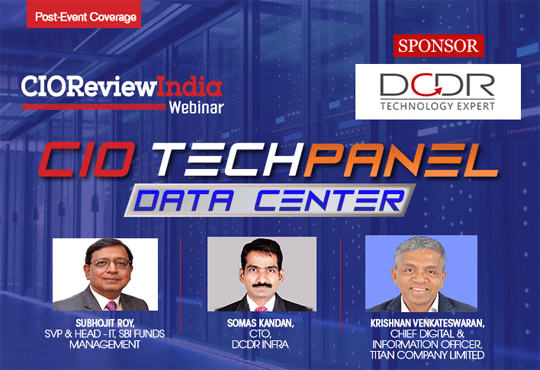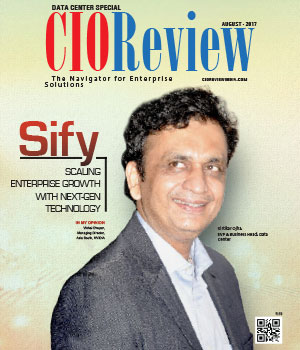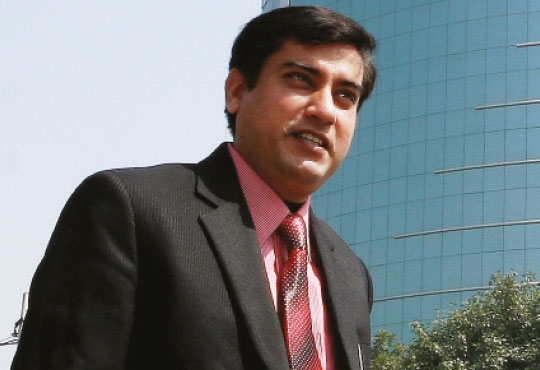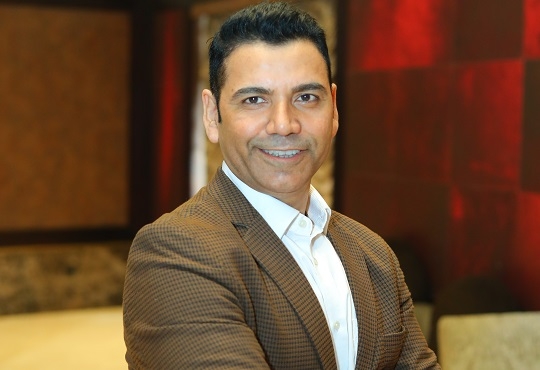
The Contours of a Successful Data Center Strategy
CIOReviewIndia Team | Thursday, 06 August 2020, 15:26 IST

Has your business been overwhelmed with data?Is the technology disruption making it imperative for your business to go digital? And as digital transformation starts in the data center, have you been perplexed as to which data center strategy to adopt and how to align the business and technology goals?
To get these questions answered, CIOReviewIndia conducted a webinar on Data Center Technology wherein it brought together CIOs from different industries who explained how enterprises can devise the right data center strategy for their business.
The guests on the panel were:
· Subhojit Roy, SVP & Head - IT, SBI Funds Management
· Krishnan Venkateswaran, Chief Digital & Information Officer, Titan Company Limited
· Somas Kandan, CTO, DCDR Infra
Evolution of Data Center Security
Kicking off the discussion, Subhojit Roy, SVP & Head-IT, SBI Funds Management, shared his views on the evolution of data center security and how businesses in the BFSI sector can cope with the challenges pertaining to adoption of right data center strategy. “There is a lot of confusion around the decision making when it comes to data security and other technology aspects of data centers. The security aspect has become even more important in the current remote working scenario. Data and data center are the two primary drivers of growth of the economy in the technology sector. Data center is the centrepiece of everything and there is a tremendous evolution in terms of the compute and networking capability which has resulted in very large and significant growth in data center space.”
“One of the primary technology advancements in the data center space is Convergence of the Infrastructure which has given several benefits to data center users in terms of managementand simplification.The other front is the software defined data center. Along with the software defined network and software defined storage,the entire data center is being driven towards software defined architecture, where the three major pieces are automation, orchestration and abstraction. These are the three pieces that are driving the software defined data center, wherein the ultimate aim is simplification. Then there is hypercoverged infrastructure or HCI which is again aimed at making things simple and reducing the workload of managing the data centers. Once we are onto data center, whether it is on-prem or cloud, the task at hand is to manage it efficiently by using AI/ML and make it more agile and faster in terms of scaling up or scaling down.”

"One of the primary technology advancements in the data center space is Convergence of the Infrastructure which has given several benefits to data center users in terms of management and simplification."
“Coming to the security aspect, the first thing we need to do is to have a cyber-security framework for a data center so that it guides you on the correct path. One of the most commonly used frameworks is NIST (National Institute of Standards and Technology). The major domains are: Identify, Protect, Detect, Respond, and Recover. When you are moving to cloud, the network becomes boundary-less. So, a new concept called Zero Trust has emerged to take care of the new security concerns, which is going to be the norm in future. And everything on top should be led by governance and risk management. For the banking and financial services sector, risk management and compliance is becoming very critical. You have to have a governance model to govern the data center and the risk management.”
“You need to have an organizational security framework and an operational security framework. Organizational security pertains to governance, risk, control, legal issues, compliance and audit. On operational security front, business continuity and disaster recovery are key imperatives. SLAs and vendor management are becoming important.”
“Though the trade-off between convenience and security will remain as users will always look for convenience and service providers will look for control, it is undergoing a continuous evolution.”
Enterprise Computing & IT Automation
Somas Kandan, CTO, DCDR Infra, expounded on the nuances of enterprise computing and data center and IT automation. “Conventionally, the three tier architecture has been adopted by most of the organizations wherein the intent is to achieve high availability. However, nowadays, there is an evident shift towards software-defined approach. Just to achieve this high availability alone, why should an organization buy an external storage which increases the cost and the footprint of your data center?
In the software-defined era, storage can also be virtualized. That is where hyperconverged infrastructure comes into the picture. All the features of external storage can be achieved in hyperconvergence from the virtualization hypervisor layer itself. With that, your data center footprint or three tier architecture which comprises server, storage, and virtualization that occupies 8-10 units of your rackspace becomes just 2 units. In a 2 unit system, you canhave a maximum of four nodes, each will two processors up to 1terabyte or even more of RAMand then internal storage of 20-40 terabytes also can be achieved. With that, your data center or your infrastructure turns into a 2u system.”
“The key advantage of HCI is that your server, compute, storage and network – everything can be managed from a single dashboard.When it comes to business continuity and disaster recovery, HCI model also takes care of that as it encompasses the same. So, there is flexibility, ease, and simplicity when you go for HCI. The benefits include: reduction of Total Cost of Ownership (TCO), enhanced performance, and increased productivity of the IT teams.”

"The key advantage of HCI is that your server, compute, storage and network – everything can be managed from a single dashboard."
“Now let’s talk about data center automation. There are routine workflows on a daily basis in a data center like scheduling, monitoring, maintenance, application delivery, and so on which need your administrator’s intervention. So, there are possibilities of human errors. To prevent such errors from happening, there are technology tools available to automate all these activities. This increases the operational efficiency and agility.”
“Another concern is data protection, which starts with operating system, followed by application and data. Today, there are technologies available to protect the entire infrastructure. How can we automate this process? Traditionally, we have seen the usage of third party back up softwares or native applications. But a single tool through which you can protect your data, replicate your data is the need of the hour. It is also extremely important whether the data is intact after restoration. With Veeam, you can accomplish the task of automation of data protection. Starting from taking back up in the onsite, or a remote site, or protecting your infrastructure on remote site or cloud, the entire activity can be automated. In addition, you can do a DR drill as well when there is a failure in the data center.”
“The third one is automating your applications. Application lifecycle management becomes very easy with Calm software from Nutanix. With Calm, you can completely automate the lifecycle of an application, starting from coding stage to finally delivering it to users. It also allows you to customize it and test it. It is as easy as downloading an application from Google play store.”
The fourth one is Artificial Intelligence/Machine Learning.Going forward, it is expected that AI/ML will drive $17 billion worth of business by 2025. With IBM Watson, you can bring AI tools and apps to your data wherever it resides – whether it's on IBM Cloud, AWS, Azure, Google, or your own private cloud platform.
So, in a nutshell, the benefits of IT automation are alignment of business and IT, speed of delivery, cost reduction, and risk mitigation. Discarding the human errors enhances your productivity.
How Retailers can devisethe Right Data Center Strategy
Krishnan Venkateswaran, Chief Digital & Information Officer, Titan Company Limited elaborated on the business and the functional aspect of retail, and the constructional underpinning of why a certain form of infrastructure would make sense in the industry and how it would depend on the kind of retailer you are. “One big imperative today is omni-channel – combining the digital and physical experience; enabling the customer to enjoy such a uniform experience that the distinction between the physical and the digital goes away.Personalization is another very intense activity that all retailers are looking at and doing very seriously. The whole point of personalization is the timely relevance.”
“Application of deep analytics is extremely intense across industries and very much so in retail; not just in customer engagement but also in merchandising, in manufacturing planning and in many other areas. In the current scenario, projecting sales has become extremely difficult. So, we are using analytical tools combined with the data that we are getting from reliable sourceson spread of the infection and the likelihood of lockdown etc.”

"The data strategy has to be clearly thought out. Which data is lying where? And if you want to drive deep analytics well, then you may say that it is inevitable that certain parts of computing have to happen at certain places but how do you then bring back and aggregate all the data into one place where you can implement holistic analytics and then send the results back."
“If youlook at a retail store as a computing unit by itself, it needs to be reasonably independent. At least the basics of billing have to be supported locally and a certain level of edge computing is also required. At the same time, you need to take care of a connected architecture as every retailer has loyalty as a very key element of engagement and customer strategy. Loyalty system has to be on the cloud and therefore connectivity is very important but at the same timelocal functionality is also a requisite.”
“Today, given the way networks are, the distinction between the physical data center and the cloud has vanished for the users. It is only the technology teams that are aware of it. It is now about self-owned versus outsourced versus going on the cloud completely. Let’s take the example of a CRM system. Today, there are several CRM systems that are cloud based and can be used with pay-as-you-go model. So, if you are not a very large retailer and you don’t have a large number of employees, then that kind of CRM would techno-functionally and commercially make perfect sense for you. But if you are an extremely large player, then you may find that theannual cost of pay-as-you—go is actually becoming high and you may want to look for other options.”
“The data strategy has to be clearly thought out. Which data is lying where? And if you want to drive deep analytics well, then you may say that it is inevitable that certain parts of computing have to happen at certain places but how do you then bring back and aggregate all the data into one place where you can implement holistic analytics and then send the results back.”
“If you are able to functionally design your architecture well, you would find that the right APIs almost suggest themselves and your integration architecture becomes that much simpler.”
Enlightened by the deep insights of the panelists, the attendees of the webinar were able to assess their data center strategy well and to change tack if needed, and those planning to design it from scratch were better informed to do that.
CIO Viewpoint
India and its Data Center Advancements
By By Michael Cantor, CIO, Park Place Technologies
How AI/Machine Learning can Revamp Data Centers...
By Piyush Kumar Chowhan, CIO and Vice President, Arvind Lifestyle Brands Limited
By Sanjay Chowdhry, CIO, Hamdard WAKF Laboratories
CXO Insights
Why A Data First Approach Could Be Your...
By Geetha Ramamoorthi, Managing Director, India, KBR Inc
A Short Guide for Data-driven and...
By Kapil Makhija, VP - Technology Cloud Business, Oracle India
The burgeoning market of prompt engineering in...







